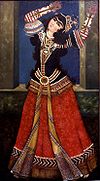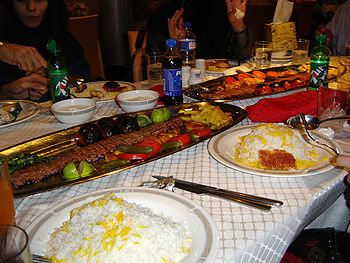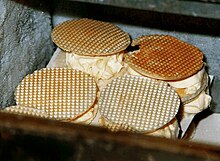Iranian cuisine
| Part of a series on the |
| Culture of Iran |
|---|
 |
|
|
The cuisine of Iran is diverse, with each province featuring dishes, as well as culinary traditions and styles, distinct to their regions. It includes a wide variety of foods ranging from chelow kabab (barg, koobideh, joojeh, shishleek, soltani, chenjeh), khoresht (stew that is served with white Basmati or Persian rice: ghormeh sabzi, gheimeh, and others), aash (a thick soup), kookoo (meat and/or vegetable pies), polow (white rice alone or with addition of meat and/or vegetables and herbs, including loobia polow, albaloo polow, zereshk polow, and others), and a diverse variety of salads, pastries, and drinks specific to different parts of Iran. The list of Persian recipes, appetizers and desserts is extensive.
Iranian food is inventive, rich and varied. It is exotic yet simple, healthy and colorful. Iranian food is not spicy. Herbs are used a lot, as is fruit from plums and pomegranates to quince, prunes, and raisins. The main Persian cuisines are combinations of rice with meat, chicken or fish and plenty of garlic, onion, vegetables, nuts, and herbs. To achieve a delicious taste and a balanced diet, unique Persian spices such as saffron, diced limes, cinnamon, and parsley are mixed delicately and used in some special dishes.
Traditional Iranian table settings

The traditional Iranian table setting firstly involves the tablecloth, called sofreh, which is often generally embroidered with traditional prayers and/or poetry, and is spread out over a Persian rug or table. Main dishes are concentrated in the center, surrounded by smaller dishes containing appetizers, condiments, side dishes, as well as bread, all of which are nearest to the diners. These latter dishes are called mokhalafat (accompaniments). When the food has been served, an invitation is made to all those seated at the sofreh to help themselves.
Essential accompaniments
There are certain accompaniments (mokhalafat) which are essential to every Iranian meal at lunch (nahar) and dinner (shahm), regardless of the region. These include, first and foremost, a plate of fresh herbs, called sabzi (basil, coriander, cilantro, tarragon, watercress), a variety of flat breads, called nan or noon (sangak, lavash, barbari), cheese (called panir, similar to feta), sliced and peeled cucumbers, sliced tomatoes and onions, yogurt, and lemon juice. Persian pickles (khiyarshur) and relishes (torshi) are also considered essential in most regions.
Tea (chai) is served at breakfast and immediately before and after each meal at lunch and dinner, and also many times throughout the rest of the day. The traditional methods of tea preparation and drinking differ between regions and peoples.
Varieties of rice

It is believed that rice (berenj in Persian) was brought to Iran from southeast Asia or the Indian subcontinent in ancient times. Varieties of rice in Iran include champa, rasmi, anbarbu, mowlai, sadri, khanjari, shekari, doodi, and others. Basmati rice from India is very similar to these Persian varieties and is also readily available in Iran. Traditionally, rice was most prevalent as a major staple item in northern Iran, while in the rest of the country bread was the dominant staple.
Methods of cooking rice
There are four primary methods of cooking rice in Iran:
- Chelow: rice that is carefully prepared through soaking and parboiling, at which point the water is drained and the rice is steamed. This method results in an exceptionally fluffy rice with the grains separated, and not sticky, and also results in a golden rice crust at the bottom of the pot called tah-digh (literally "bottom of the pot"), which is exceptionally popular with Iranian children.
- Polow: rice that is cooked exactly the same as chelow, with the exception that after draining the rice, other ingredients are added in layers or sections of the rice, and then steamed together.
- Kateh: rice that is cooked until the water is absorbed. This is also the traditional dish of Gilan (described in detail below).
- Damy: cooked almost the same as kateh, except that the heat is reduced just before boiling and a towel is placed between the lid and the pot to prevent steam from escaping. Damy literally means "simmered."
Varieties of bread
There are four major Iranian flat breads:
- Nan-e barbari: thick and oval-shaped.
- Nan-e lavash: thin, crispy and round or oval, and is also the oldest known bread in the Middle East and Central Asia.
- Nan-e sangak: dark and oval-shaped bread that is stone-baked.
- Nan-e taftoon: thin, soft and round.
Other breads include:
- Nan-e shirmal: made exactly like barbari, except with milk instead of water, in addition to a bit of sugar, and is eaten during breakfast or with tea.
- Nan-e gisu: a sweet Armenian bread, and also is eaten in the morning or with tea later in the day.
Regional cuisines
Gilan
Kateh is the traditional dish of Gilan, and is simply Persian rice cooked in water, butter and salt until the water is fully absorbed. This method results in rice that is clumped together and is the predominant style of cooking rice in the Caspian region. In Gilan and Mazandaran, kateh is also eaten as a breakfast meal, either heated with milk and jam, or cold with Persian cheese (panir) and garlic. Kateh is not commonly served in other parts of Iran, but is prescribed widely as a natural remedy for those who are sick with the common cold or flu, and also for those suffering from stomach pains and ulcers.
The Gilani variety of rice is considered the best in Iran, where it has been cultivated since the fourth century BCE.
Khuzestan
See Khuzestan: People and Culture
Fast food, imported and adapted foods
Popular fast food items in Iran include chelow kabab (literally "rice and kabab"), joojeh kabab (the same, but substituting grilled or broiled chicken), nan-e kabab (literally "bread with kabab"), kabab sandwiches, and a number of different derivatives of traditional slow-cooked meals. An increasing preference for American style food amongst a younger generation of Iranians has resulted in the establishment of many pizza, steak, hamburger, and fried chicken establishments, but Western food is sometimes served alongside staples such as those mentioned above, and is often prepared differently (most notably with pizza). Chinese and Japanese cuisine has also become popular in recent years, primarily in Tehran, and Indian, Italian and Mediterranean restaurants are also featured.
Breakfast (sobhaneh)
The basic traditional Iranian breakfast consists of a variety of flat breads (noon-e sangak, lavash, and others), butter, Tabrizi white cheese, feta cheese, whipped heavy cream (sarshir, often sweetened), and a variety of fruit jams and spreads. However, other popular traditional breakfasts (which require far more preparation) include haleem (wheatmeal with shredded lamb - similar to Western oatmeal in some respects), asheh mohshalah (thick soup), kaleh pacheh (lamb or sheep's head and feet soup), and others. These latter breakfasts are typically regional specialities, and many cities and towns all across Iran feature their own distinct versions of these dishes. Both asheh mohshalah and haleem are typically prepared the night before, to be served the next morning, and haleem is usually only served at certain times of the year (haleem specialty restaurants are only open during those times), except in southern parts of Iran, where haleem is always present. Kaleh pacheh is almost always only served from three in the morning until sometime after dawn, and specialty restaurants (serving only kaleh pacheh) are only open during those hours.
Lunch and dinner (nahar va shahm)
Traditional Persian cooking is done in stages, at times needing hours of preparation and attention. The outcome is a well-balanced mixture of herbs, meat, beans, dairy products and vegetables. Major staples of Iranian food that are usually eaten with every meal include rice, various herbs (mint, basil, dill, parsley), cheese (feta or Persian panir, derived from goat or sheep's milk, and sometimes cow's milk), a variety of flat breads, and some type of meat (usually fowl, beef, lamb, or fish). Stew over rice is by far the most popular dish, and the constitution of these vary by region. Tea (chai) is the drink of choice on nearly every occasion, and is usually served with fruit, pastries, or sweets.
You can usually find tea brewing throughout the day in most Iranian homes. Doogh, a yogurt drink, is also quite popular. One of the oldest recipies, which can trace it's existence back to the time of Persian empire, is khoresht-e-fesenjan,consisting of duck or sometimes chicken in a rich pomengranate and walnut sauce that yields a distinctive brown color, most often served with white rice. The taste is exceptional and fuses both sweet and sour in perfect harmony.
Persian cuisine in the West
One of the main reasons that Persian cuisine is not widely recognized is that it is often confused with Middle Eastern cuisine, a much broader and more general term, and this confusion is further perpetuated by restaurants and markets providing authentic Persian cuisine that label themselves as such. Many Persian markets and restaurants are labelled as Middle Eastern, International, or Mediterranean in order to broaden their appeal to the Western consumer. In reality, Persian cuisine is one of the oldest and richest cuisines in the world, and is typically vastly different from what is found in the greater Middle East. Although not widely recognized, Persian cuisine is gaining popularity in multicultural cities, especially in Los Angeles, which has a significant Persian population.
Drinks and Dessert

The traditional drink accompanying Iranian dishes is called doogh. However many domestic soda beverages such as Zam Zam Cola and its competition Parsi Cola are widely consumed with meals. Both Coca Cola and Pepsi Cola have officially licensed bottling plants in Mashad, with their products surprisingly not subject to US sanctions against Iran. Other drinks are several types of especially prepared Sherbets and khak sheer.
There are many dessert dishes, ranging from Bastani-e Zafarani (Persian Ice-Cream, also called Bastani-e Gol-e Bolbol0 to the faludeh. Persian Ice-Cream is flavoured with saffron, rosewater, and chunks of heavy cream. There are also many types of sweets. The sweets remain in two categories: "Shirini Tar" (lit. wet sweets) and "Shirini Khoshk" (lit. dry sweets). The first category consists of French-inspired pastries with heavy whipped cream, glazed fruit toppings, tarts, custard-filled eclairs, and a variety of cakes. Some have an Iranian twist such as the addition of pistachio, saffron, and walnuts. The second category consists of more traditional sweets: Shirini Berenji (a type of rice cookie), Shirini Nokhodchi (clover shaped, chickpea cookies), Kouloucheh (a large cookie usually with a walnut or fig filling), Shirini Kishmishi (raisin and saffron cookies), Shirini Yazdi (muffins or cupcakes from the city of Yazd), and more. Three others Zulbia, Bamieh and Gush-e Fil, are very popular. Bamiehs are oval-shaped dough pieces, deep fried and then covered with a syrup. Zulbia is also deep-fried dough, but it is poured into the oil so that it twirls. It is then covered with the same syrup. Gush-e Fil (lit. Elephant ears) are also deep-fried dough, fried in the shape of flat elephant ears and then covered in syrup.
Alcoholic beverages
Though strictly banned sometime after the Islamic Revolution of 1979, alcoholic beverages may be readily available in Iran, but they are not openly available. The most common beverage is called aragh-e sagi, which is domestically produced, with the best variety available in the province of Qazvin. Vodka is the second most commonly available alcohol, with most quantities imported directly from Russia. Some domestic varieties of vodka are available, but cannot be easily obtained. Beer is the third most common alcoholic beverage, with much of it imported from northern Europe via Turkey. As with vodka, domestic beer is available, but not easily obtained. Other imported liquors such as Scotch whisky, gin, and higher quality vodkas from Poland are available in some major cities, but at a much higher cost (typically even more expensive than the Western average) and as such are considered luxury items.
Wine has been a major part of Iranian culture since ancient times, and this tradition has continued despite current governmental restrictions. The major wine-producing centers of Iran are Qazvin, Orumiyeh, Shiraz, and to a lesser extent, Isfahan. Red wine is the most common variety and also the most popular, with white wine also enjoying a strong position in the north. Wine-producers are often, but not always, either of Armenian or Zoroastrian background, as non-Muslim minority groups are entitled the right to produce wine (and other alcoholic beverages) for their own use. Though it is illegal for them to sell wine to other Iranians (and to foreign visitors), this rule may not be followed and their wine may be obtained in those parts of the country where it is produced or distributed. The Armenian producers of Orumiyeh and Isfahan are, in particular, renowned for their sweet, sparkling red wines.
Vegetarianism in Iran
The concept of vegetarianism is uncommon in Iran, though many vegetarian dishes are featured and in recent decades there has been growing interest in this area (and in fruitarianism) since the 1960s, particularly amongst the youth. A small number of vegetarian restaurants and coffee shops are featured in the major urban centers. Some of the most popular vegetarian dishes are:
- Kashk-e baademjan
- Kookoo-e baademjan
- Kookoo-e gol-e kalam
- Kookoo-e sabzi which usually accompanies Sabzi-polo ba Mahi
- Mirza ghasemi
- Naaz khatoon
- Nargesi esfenaaj
- Borani esfenaaj
Bibliography
- New Food of Life by Najmieh Batmanglij (ISBN 0934211345)
- H.E. Chehabi, "The Westernization of Iranian Culinary Culture", Iranian Studies
